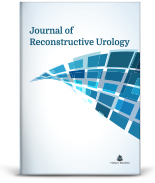Amaç: Üreter taşlarının beden dışı şok dalga (ESWL) ile tedavisinde, Hounsfield ünitesi (HÜ) ile birlikte başarıyı etkileyen diğer faktörlerin analiz edilmesidir. Gereç ve Yöntemler: Polikliniğimize başvuran hastalar içinde, bilgisayarlı tomografide üreter taşı saptanan 85 hasta çalışmaya dâhil edildi ve hastalara ESWL planlandı. Hastaların demografik verileri, taş karakteristikleri ve ESWL sonuçları ileriye dönük olarak kaydedildi. Tek böbrekli hastalar, non opak taşa sahip olanlar, önceki üriner sistem cerrahisi olanlar, üriner sistem anomalisi olanlar, böbrek yetmezliği olanlar ve eksik verileri olanlar çalışma dışı bırakıldı. ESWL öncesi her hastaya rutin olarak idrar kültürü, hemogram, biyokimya (kreatinin, elektrolitler, karaciğer enzimleri) ve koagülasyon testleri yapıldı. Ağrı kesici olarak kas içi 75 mg diklofenak sodyum kullanıldı. Bulgular: Otuz sekiz proksimal üreter taşlı hastanın 32 (%84,2)'sinin, 22 distal üreter taşlı hastanın 11 (%50)'inin taşlarının tamamen temizlendiği görüldü. ESWL tedavisi başarılı olanların ortalama beden kitle indeksi (BKİ) 24,5 kg/m2 iken, başarısız olanların 29,5 kg/m2 idi. Tedavisinin başarıya ulaştığı taşların ortalama HÜ'si (597) başarısız olanların HÜ'sinden (880) daha küçüktü. Spontan taş düşürme öyküsü olan hastalarda taşsızlık oranları istatistiksel olarak anlamlı derecede spontan taş düşürme hikâyesi olmayanlardan daha yüksek idi. Sonuç: Çalışmamızın sonunda ortaya çıkan veriler, artan BKİ ve HÜ'nin taşın kırılmasını zorlaştırdığını, spotan taş düşürme hikâyesi olan hastalarda daha yüksek oranda taşsızlık sağlandığını ve proksimal üreter taşlarının distal üreter taşlarından daha yüksek başarı oranlarıyla kırıldığını ortaya koymuştur.
Anahtar Kelimeler: Üreter taşları; litotripsi
Objective: The aim of this study is to analyze the effect of stone computed tomography Hounsfield unit (HU) and other factors on the success of extracorporeal shock wave lithotripsy (ESWL) treatment of ureteral stones. Material and Methods: Among the patients, who applied to our polyclinic, 85 patients with ureteral calculi were included in the study and ESWL was planned. Demographic data, stone characteristics and ESWL results were recorded prospectively. Patients with single kidney, patients with non-opaque stones, patients with previous urinary tract surgery, patients with urinary system anomalies, patients with renal insufficiency and patients with missing data were excluded from the study. Results: 32 (84.2%) of 38 patients with the proximal ureteral stones and 11 (50%) of 22 patients with the distal ureteral stones had complete calculi clearance. The mean body mass index (BMI)s of patients whose stones were treated successfully and unsuccessfully with the ESWL were 24.5 kg/m2 and 29.5 kg/m2, respectively. The mean HUs of stones which were treated successfully and unsuccessfully with the ESWL were 597 and 880, respectively. Complete calculi clearance rate of patients whose medical history has spontaneous stone passage was higher than patients whose medical history does not have spontaneous stone passage. Conclusion: The results of this study show that high BMI of patients and HU levels of stones make stone clearance more difficult than low levels. Opposite to this, presence of spontaneous Stone passage history makes easier having complete calculi clearance. Finally, similar to the literature, it has been showed that the clearance of proximal ureteral stones with ESWL is easier than distal ureteral stones.
Keywords: Ureteral calculi; lithotripsy
- Chaussy C, Brendel W, Schniedt E. Extracorporeally induced destruction of kidney stones by shock waves. Lancet. 1980;2(8207):1265-8. [Crossref]
- Martin TV, Sosa RE. Shock-wave lithotripsy. Campbell's Urology. 7th ed. Philadelphia: WB Saunders Inc; 1998. p.2735-52.
- Bon D, Dore B, Irani J, Marroncle M, Aubert J. Radiographic prognostic criteria for extracorporeal shock-wave lithotripsy: a study of 485 patients. Urology. 1996;48(4):556-61. [Crossref]
- Dretler SP. Stone fragility--a new therapeutic distinction. J Urol. 1988;139(5):1124-7. [Crossref]
- Federle MP, McAninch JW, Kaiser JA, Goodman PC, Roberts J, Mall JC. Computed tomography of urinary calculi. AJR Am J Roentgenol. 1981;136(2):255-8. [Crossref] [PubMed]
- Parienty RA, Ducellier R, Pradel J, Lubrano JM, Coquille F, Richard F. Diagnostic value of CT numbers in pelvocalyceal filling defects. Radiology. 1982;145(3):743-7.
- Mostafavi MR, Ernst RD, Saltzman B. Accurate determination of chemical composition of urinary calculi by spiral computerized tomography. J Urol. 1998;159(3):673-5. [Crossref]
- Preminger GM, Tiselius HG, Assimos DG, Alken P, Buck AC, Gallucci M, et al. 2007 Guideline for the management of ureteral calculi. Eur Urol. 2007;52(6):1610-31. [Crossref] [PubMed]
- Tiselius HG. How efficient is extracorporeal shockwave lithotripsy with modern lithotripters for removal of ureteral stones? J Endourol. 2008;22(2):249-55. [Crossref] [PubMed]
- Elashry OM, Elgamasy AK, Sabaa MA, Abo-Elenien M, Omar MA, Eltatawy HH, et al. Ureteroscopic management of lower ureteric calculi: a 15-year single-centre experience. BJU Int. 2008;102(8):1010-7. [Crossref] [PubMed]
- Fuganti PE, Pires S, Branco R, Porto J. Predictive factors for intraoperative complications in semirigid ureteroscopy: analysis of 1235 ballistic ureterolithotripsies. Urology. 2008;72(4):770-4. [Crossref] [PubMed]
- Tugcu V, Tasci AI, Ozbek E, Aras B, Verim L, Gurkan L. Does stone dimension affect the effectiveness of ureteroscopic lithotripsy in distal ureteral stones? Int Urol Nephrol. 2008;40(2):269-75. [Crossref] [PubMed]
- Dretler SP, Polykoff G. Calcium oxalate stone morphology: fine tuning our therapeutic distinctions. J Urol. 1996;155(3):828-33. [Crossref]
- Wang YH, Grenabo L, Hedelin H, Pettersson S, Wikholm G, Zachrisson BF. Analysis of stone fragility in vitro and in vivo with piezoelectric shock waves using the EDAP LT-01. J Urol. 1993;149(4):699-702.
- Ramakumar S, Patterson DE, LeRoy AJ, Bender CE, Erickson SB, Wilson DM, et al. Prediction of stone composition from plain radiographs: a prospective study. J Endourol. 1999;13(6):397-401.
- Dretler SP, Spencer BA. CT and stone fragility. J Endourol. 2001;15(1):31-6. [Crossref] [PubMed]
- Joseph P, Mandal AK, Singh SK, Mandal P, Sankhwar SN, Sharma SK. Computerized tomography attenuation value of renal calculus: can it predict successful fragmentation of the calculus by extracorporeal shock wave lithotripsy? A preliminary study. J Urol. 2002;167(5):1968-71. [Crossref]
- Pareek G, Armenakas NA, Panagopoulos G, Bruno JJ, Fracchia JA. Extracorporeal shock wave lithotripsy success based on body mass index and Hounsfield units. Urology. 2005;65(1):33-6. [Crossref] [PubMed]







.: Process List